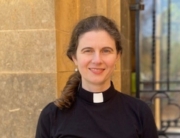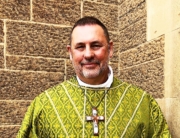Preacher: The Very Rev’d Frank Nelson, Dean
It’s absurd really. How can any thinking right-minded rational 21st century person possibly believe the claims of Christians that Jesus Christ rose from the dead and is alive? Easter after Easter this sort of question is trotted out in the comments section of news reports on Christians gathering for worship over Easter, or when Christians object to sport making it difficult to get to cathedrals and churches. But actually, the question is the wrong one. It’s not how can 21st century people believe. It’s how can anyone, in any century, believe? It’s a good question to ask and keep on asking. I hope you are asking it of yourself today.
Look at the evidence – such as it is. Four ancient pieces of writing called Gospels. None of them really agrees with the others.
Luke – whose account we read this morning – has a group of women go to the tomb. It is empty, the stone rolled away. Two men in dazzling clothes greet them with a message. “He is not here, but has risen.” The names of the women? Mary Magdalene, Joanna, Mary the mother of James and others, unnamed. Peter runs to have a look.
Matthew says two women went to the tomb – Mary Magdalene and the ‘other Mary’. He writes about an earthquake, an angel and terrified guards. Matthew tells a story of the authorities bribing the guards to say the body was stolen.
Mark has the shortest account of that day. Three women, Mary Magdalene, Mary the mother of James and Salome, go to the tomb carrying spices to anoint the body of Jesus. The stone is already rolled away and a young man meets them with a message. Similar in content to that found in Luke and Matthew it is the ending of Mark’s account that is a bit different. The terrified women fled from the tomb and the garden. They said nothing to anyone for they were afraid. Later readers found this ending unsatisfactory and added other endings.
St John has yet another take on the matter. One woman, Mary Magdalene, discovers the empty tomb; Peter and the beloved disciple race to see for themselves; Mary mistakes Jesus for the gardener at first.
The evidence is confused, to say the least. So yes, it’s a good question – how can anyone, in any century, believe?
Let’s look at it differently. Ignore the detail for the moment. The real point of all four Gospel accounts of the first Easter Day is that something happened to make those women who went to the tomb in the garden, and the terrified disciples of Jesus, change. Somehow or other they came to believe that Jesus had been raised from the dead. That Jesus was alive again. And that changed their lives – for ever.
And this is the odd thing about Christians. Despite that excellent question with which we began – can anyone, in any century, believe that Jesus Christ rose from the dead – Christians believe he did. Not only do they believe it, they believe so much that their lives are changed by that belief.
Yes, we struggle. We have doubts. We speculate. We vacillate. Yet, in the end, and despite the fact that the resurrection cannot be empirically proven, we believe. And we are not alone in that. Millions upon millions of people will gather in churches and cathedrals today because they believe – or they want to believe. And this has been the case for centuries – more than twenty of them now. This belief that Jesus has died, and is alive again, this belief changes the lives of individuals and continues to change the world. This belief is captured in the ancient, thrilling and spine-tingling cry of Easter Day:
‘Christ is risen! He is risen indeed! Alleluia!’
To the shame of all Christians we have to acknowledge that there have been terrible things done in the name of religion and Christianity. We can’t ignore that. But they are far outweighed by the transformation of people, by the enormous amount of energy for good that has poured out century after century from those who profess to believe that Christ was raised from the dead. How does this happen? Why should it happen if it is all a myth, a fairy story on a par with the Easter bunny? Thinking, intelligent, world-influencing people from all walks of life, continue to believe and live as if Christ is risen. They continue to search the scriptures, to unpack them and make sense of them, as Jesus himself did in the next part of Luke’s Gospel (if you care to read on in chapter 24). They model their lives on the teaching and example of Jesus Christ. And that makes a difference in the world.
Today’s reading from Isaiah is one that was pored over in the struggle to make sense of this extraordinary claim that Jesus had risen from the dead. It is just one of many readings that hold up a vision of a better world, that inspire Christians and others, to work for that better world. A world of rejoicing, not fear; a world where people are treated fairly, where hard work is honoured and acknowledged by letting the workers enjoy the fruits of their labour; a world where children do not die because of poor sanitation, or lack of adequate food and health-care for treating preventable diseases; a world where people are not forced from their homes and countries by the greed, the arrogance, the naked lust for power that sees suicide bombers at airports and long-distance drones drop bombs on villages; a world where, in a remarkably challenging and provocative metaphor, the wolf and the lamb feed together, and the lion eat straw like the ox.
This morning five people, three adults and two children, will be baptised into Christ. In doing so they formally buy into this story that Mary Magdalene and the other women, that Peter and John and the other disciples, and all who have called themselves, and continue to call themselves, Christians believe – that Jesus Christ, who was crucified on a cross under Pontius Pilate, died and was buried, was raised to life on the third day, and is alive today. It’s a story that, in the words of St Paul, is a stumbling block and foolishness to many but, to those who are called and who believe, is the ‘power of God and the wisdom of God’. (1 Cor 1: 21)
It may be you have come here this morning wondering whether or not it is true, whether you can possibly believe. Weigh carefully the evidence – the fact of four different accounts by the Gospel writers, the changed lives of those first Christians, the good done in the name of Christ through the ages. Don’t be afraid of mystery. Don’t be afraid of trust and faith. Weigh it all up and then, if you are ready, join those who do believe, who worship the risen One, who are baptised and marked with the sign of the cross, who come, as we do today and every Easter to proclaim that:
Christ is risen! He is risen indeed! Alleluia!



